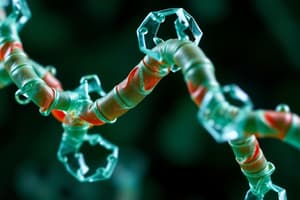Podcast
Questions and Answers
What is the primary role of enzymes in chemical reactions?
What is the primary role of enzymes in chemical reactions?
- Act as reactants in the reaction
- Change the equilibrium of a reaction
- Decrease the reaction rate
- Increase the reaction rate by decreasing activation energy (correct)
Enzymes are consumed during the chemical reaction they catalyze.
Enzymes are consumed during the chemical reaction they catalyze.
False (B)
Name one of the fastest known enzymes.
Name one of the fastest known enzymes.
Carbonic anhydrase
Enzymes exhibit _____ for substrate and reaction.
Enzymes exhibit _____ for substrate and reaction.
Match the following enzyme classifications with their definitions:
Match the following enzyme classifications with their definitions:
Which of the following statements about enzyme efficiency is true?
Which of the following statements about enzyme efficiency is true?
Ribozymes are proteins that act as enzymes.
Ribozymes are proteins that act as enzymes.
List three enzyme classifications.
List three enzyme classifications.
What is the term for the catalytically active form of an enzyme?
What is the term for the catalytically active form of an enzyme?
Enzyme activity decreases with increasing pH levels for all enzymes.
Enzyme activity decreases with increasing pH levels for all enzymes.
What is the term used to describe a substance that decreases the velocity of an enzyme-catalyzed reaction?
What is the term used to describe a substance that decreases the velocity of an enzyme-catalyzed reaction?
The enzyme that converts 1 µmol of substrate in 1 minute under optimal conditions has a unit of ___.
The enzyme that converts 1 µmol of substrate in 1 minute under optimal conditions has a unit of ___.
Match the following terms with their definitions:
Match the following terms with their definitions:
Which factor does NOT affect enzyme activity?
Which factor does NOT affect enzyme activity?
The optimum temperature for most human enzymes is around 25-30 °C.
The optimum temperature for most human enzymes is around 25-30 °C.
What term describes the temperature at which an enzyme shows maximum activity?
What term describes the temperature at which an enzyme shows maximum activity?
Flashcards
What are enzymes?
What are enzymes?
Enzymes are biological catalysts that speed up chemical reactions in living organisms.
What are enzymes made of?
What are enzymes made of?
Enzymes are primarily proteins, but some are RNA molecules called ribozymes.
How do enzymes affect reactions?
How do enzymes affect reactions?
Enzymes speed up reactions but do not change the direction or the equilibrium of the reaction.
What is enzyme specificity?
What is enzyme specificity?
Signup and view all the flashcards
How efficient are enzymes?
How efficient are enzymes?
Signup and view all the flashcards
What is an example of a fast enzyme?
What is an example of a fast enzyme?
Signup and view all the flashcards
How are enzymes classified?
How are enzymes classified?
Signup and view all the flashcards
What are the six enzyme classes?
What are the six enzyme classes?
Signup and view all the flashcards
Apoenzyme
Apoenzyme
Signup and view all the flashcards
Cofactor
Cofactor
Signup and view all the flashcards
Holoenzyme
Holoenzyme
Signup and view all the flashcards
Active Site
Active Site
Signup and view all the flashcards
Enzyme Activity
Enzyme Activity
Signup and view all the flashcards
Optimum Temperature
Optimum Temperature
Signup and view all the flashcards
Optimum pH
Optimum pH
Signup and view all the flashcards
Inhibitor
Inhibitor
Signup and view all the flashcards
Study Notes
Enzymes
- Enzymes are biocatalysts that increase reaction rates by lowering activation energy.
- They are not consumed in the reaction.
- Enzymes are highly specific for their substrates and reactions.
- They speed up reactions but do not change the equilibrium constant.
- Most enzymes are proteins, but some are ribozymes (catalytic RNA).
Learning Objectives
- Describe features and properties of enzymes
- List enzyme classifications in the correct order
- Describe factors affecting enzyme activity
- Explain Km and its relationship to activity
- Explain enzyme inhibition and its types
Metabolic Reactions
- Enzymes facilitate both anabolic (building up) and catabolic (breaking down) reactions.
- Enzymes drastically increase reaction speed in both cases.
- Enzymes facilitate reactions by binding to substrates; this changes the substrate into products.
- Some molecules can also be transported via enzymes
Glycolysis
- Glycolysis is a metabolic pathway that breaks down glucose into pyruvate.
- Enzymes are crucial throughout this process, each performing specific reactions.
- The enzymes are shown in a diagram on one slide.
Metabolism of Complex Molecules
- This slide shows an interconnected map of various metabolic pathways.
- The map depicts how different molecules and their metabolisms connect and interact.
Activation Energy
- Activation energy is the minimum energy required to initiate a chemical reaction.
- Enzymes reduce activation energy and make reactions happen faster.
- Without the enzyme, the required activation energy is higher to complete the reaction.
Activation Energy and Catalysts
- Catalysts, including enzymes, reduce activation energy without changing the nature or amounts of reactants or products.
- Catalysts, including enzymes, are not consumed during the reaction.
Enzyme Structure
- Apoenzyme: Protein portion of an enzyme.
- Cofactor: Non-protein component of the enzyme (required for activity).
- Holoenzyme: Complete, catalytically active enzyme with all its components (apoenzyme + cofactor).
- The interaction of the substrate with the active site gives rise to the product.
Properties of Enzymes
- Enzymes are highly specific for their substrates and reactions.
- They change the rate, not the equilibrium, of a reaction.
- They work by creating special bonds with the substrates.
Efficiency
- Enzymes increase reaction rates significantly (10³ to 10⁸ times faster).
- Carbonic anhydrase is a high-speed example.
Specificity
- Reaction specificity: Each enzyme catalyzes a specific type of reaction.
- Substrate specificity: Each enzyme works on specific substrates or chemically related molecules.
Enzyme Nomenclature: Classification
- Enzyme classification follows a numbering system (EC number).
- Different classes exist, each defined by the type of reaction those enzymes carry out.
Enzyme Kinetics and Km
- Km represents the substrate concentration at half the maximum reaction rate (1/2 Vmax).
- Km reflects the affinity of an enzyme for its substrate.
- High affinity (faster reactions) has a small Km.
- Low affinity (slower reactions) has a high Km
Km, A Clinical Example
- Km of an enzyme affects how efficiently it functions, and is useful for clinical diagnosis.
- Alcohol dehydrogenase is used as an enzymatic example.
Enzyme Activity
- Enzyme activity is the speed of converting substrate to product in a given period.
- Unit activity measures how many substrate molecules an enzyme changes into product.
Factors Affecting Enzyme Activity
- Enzyme concentration: Higher concentrations increase reaction rate.
- Substrate concentration: Higher concentrations increase reaction rate until saturation.
- Temperature: Optimal temperature increases reaction rate before it declines, due to denaturation.
- pH: Optimal pH increases reaction rate before it decreases due to denaturation.
- Inhibitors: Substances that decrease the reaction rate
Inhibitors
- Reversible inhibitors bind non-covalently, meaning their binding is temporary.
- Irreversible inhibitors bind covalently, making the enzyme unusable.
Reversible Inhibition
- Competitive inhibitors bind to the active site, blocking substrate binding.
- Noncompetitive inhibitors bind to a different site, changing the enzyme's shape and hindering catalysis.
- Uncompetitive inhibitors bind to the enzyme-substrate complex.
Regulation of Enzyme Activity
- Enzyme amount (synthesis and degradation): Controlling enzyme production and breakdown.
- Enzyme modification (phosphorylation, etc.): Altering enzyme activity through covalent modifications.
- Enzyme compartments (mitochondria, cytosol, lysosome etc.): Locating enzymes in specific cellular compartments, controls what molecules the enzyme works on.
Studying That Suits You
Use AI to generate personalized quizzes and flashcards to suit your learning preferences.
Related Documents
Description
This quiz covers the fundamental aspects of enzymes, including their properties, classification, and factors affecting their activity. It also explores the role of enzymes in metabolic reactions and their significance in processes such as glycolysis. Test your knowledge on biocatalysts and their critical functions in biochemical reactions.




